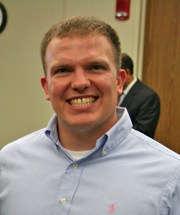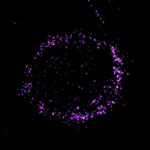Restoring muscle function in a rare, devastating disease: Part 2

Part 2 of a two-part series. (Read part 1.)
Back in the 1990s, rheumatologist Richard Weisbart, MD, of University of California, Los Angeles (UCLA), was studying lupus in a mouse model and found that the mice were making an antibody that had the intriguing ability to get inside tissues and cells.
Weisbart shifted his work away from studying lupus to studying and refining the antibody, called 3E10, and he and others showed that proteins could be delivered into different tissues of the body simply by attaching them to a fragment of 3E10.
Dustin Armstrong, PhD, a postdoc at Novartis at the time, was trying to find molecules that could activate growth in weakened muscles—without activating possibly cancerous growth in other tissues. He saw Weisbart’s work and contacted UCLA. In 2008, he obtained seed money and founded a company around 3E10-based therapeutics for muscular diseases, now known as Valerion Therapeutics (formerly 4s3 Bioscience).
“There’s a huge need for therapies for genetic muscle diseases, and muscle was a tissue we could target well with our technology,” says Armstrong. “The 3E10 antibody requires a membrane transporter to enter cells—and skeletal muscle has 20-fold higher expression of this transporter.”

Armstrong saw X-linked myotubular myopathy (MTM)—a rare, generally fatal disorder causing muscle weakness in boys—as an ideal test case for the technology. Scientists like Alan Beggs, PhD, at Boston Children’s Hospital, had extensively studied MTM and had shown success in animal models with gene therapy to replace the enzyme myotubularin, lost or damaged through mutations to the MTM1 gene (see part 1). Of 300 to 400 MTM cases known in the world, Beggs’s lab has enrolled close to 70, collecting genetic samples and detailed clinical data.
“There’s a clear indication from the gene therapy work that if you could replace myotubularin, you could have an immediate effect on muscle,” Armstrong says. “Alan brings a large depth of experience in the genetic aspects of congenital muscle myopathies, and his lab has animal models and experience doing physiologic testing. That creates opportunities to do drug development.”
Homing to muscles

Beggs welcomed having another option to test. Although gene therapy has advanced greatly from its early days, direct enzyme replacement is potentially safer, since dosing can be better controlled.
He and Armstrong received a venture philanthropy grant from the Muscular Dystrophy Association (MDA). In the April 15 issue of Human Molecular Genetics, they showed that injection of myotubularin—attached to the 3E10 fragment—into the leg muscles of mice reversed muscle weakness and improved muscle structure.
“We gave a dose that we thought would be sufficient for just one limb, but it circulated in the blood and treated the entire animal,” says Beggs. “Since it’s an enzyme, we don’t have to replace a lot of it—a little bit goes a long way.”
Enzyme replacement could have a relatively fast path to clinic. There’s regulatory precedent for enzyme-based drugs, notably Genzyme’s Myozyme, approved by the FDA in 2008 for Pompe disease, another rare genetic disorder.
Under a pending $1.2 million grant from the MDA, Armstrong and Beggs plan to further the animal studies and figure out questions of dosage, timing of treatment, how often treatment would need to be repeated and whether the body will tolerate enzyme replacement long-term. But Beggs wants to continue developing gene therapy too.
“The best therapy might be a combination therapy,” he says. “You could give a child gene therapy first, and wait for it to wear off, or for the immune system to reject the virus. You could try this for two to three years and follow it with the protein therapy. An alternative scenario is to do both at the same time to more fully deliver the treatment to the entire body. It’s important to have more than one way to skin the cat.”
With either approach, a big question is whether the treatment will work once muscle weakness is established. Unlike dogs and mice, which develop weakness after birth, children with MTM are born weak, often nearly motionless.
“I definitely think, having followed Alan’s work over the years, that things are getting close,” says Erin Ward, whose son Will has MTM, and who, with her husband Mark, helps direct the MTM-CNM Family Conference, which next meets in July. “We’re educating the community about how to hold onto that hope and what a clinical trial process would look like. We’re kind of on that threshold, I feel.”
“Once they get the delivery process down, it is likely this science will translate to other similar neuromuscular diseases,” says Alison Frase, whose son Joshua passed away from MTM two years ago, at the age of 15. Joshua’s favorite biblical scripture, posted on the Frase Foundation’s website, perhaps best captures that feeling of hope.
“But they that wait upon the Lord shall renew their strength. They shall mount up with wings as eagles. They shall run and not be weary, and they shall walk and not faint.” —Isaiah 40:31.
End of series.
[Ed. note: For more information about this research and to discuss partnership opportunities, please contact the Technology & Innovation Development Office, 617-919-3019 or TIDO@childrens.harvard.edu. To learn about supporting the research, please contact morgan.herman@chtrust.org.]
Related Posts :
-

Thanks to Carter and his family, people are talking about spastic paraplegia
Nine-year-old Carter may be the most devoted — and popular — sports fan in his Connecticut town. “He loves all sports,” ...
-

A new druggable cancer target: RNA-binding proteins on the cell surface
In 2021, research led by Ryan Flynn, MD, PhD, and his mentor, Nobel laureate Carolyn Bertozzi, PhD, opened a new chapter ...
-

Genomic sequencing transforms a life: Asa’s story
Asa Cibelli feels like he’s been reborn. The straight-A middle schooler plays basketball and football, does jiu jitsu, is ...
-

Phenylketonuria: Giving treatment a second chance
Phenylketonuria (PKU) was once a common cause of intellectual disability. Children born with this metabolic condition lack phenylalanine hydroxylase (PAH), ...





